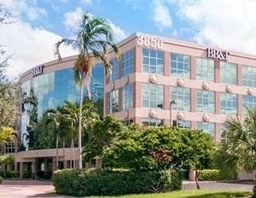
Skin cancer is one of the most common cancers, but early detection and advanced treatments like Mohs surgery make it highly treatable.
At Hollywood Dermatology, our board-certified dermatologists provide Mohs surgery for patients across South Florida. Our five locations in Hollywood, Pembroke Pines, Miramar, Doral, and Kendall offer a full range of clinical and cosmetic dermatology services to meet the needs of patients of all ages.
What is Mohs surgery?
Mohs surgery, named after Frederick Mohs, is the most effective technique available in treating skin cancer. Performed in an outpatient procedure, Mohs surgery entirely removes the affected skin cancer area while sparing the surrounding healthy skin.
When is Mohs surgery appropriate?
Mohs surgery is commonly used to remove large skin cancers, skin cancers in hard-to-reach places, recurrent skin cancers, and those occurring in areas where preservation of the skin is essential (such as the tissue surrounding the eyes and nose). This procedure can be performed on basal cell or squamous cell carcinomas. It may also be useful for melanoma.
What are the advantages of Mohs Surgery?
The primary advantage of Mohs surgery is that this procedure offers a cure rate that is higher than 99%. Additional benefits include:
- No guesswork. The surgeon creates a precise map of cancerous cells and the margins of healthy tissue.
- Mohs typically removes the entirety of cancerous cells in an area, significantly reducing the chances of recurrence.
- The conservative, precision technique preserves the greatest amount of healthy tissue.
- Cancer treatment and reconstructive repair, if needed, can often be scheduled for the same day.
How Is Mohs Surgery Different From Other Types of Surgery?
Mohs differs from traditional skin cancer surgery in one major way, it is highly tissue-sparing. During traditional skin cancer surgery, the doctor estimates the width and depth of cancerous cells. To remove all cancer, they remove a designated margin of healthy skin around the estimated area as well. The tissue specimen is sent to a lab for confirmation of clear margins. This examination can take several days.
Mohs surgery removes tissue in layers. The removed tissue is immediately examined under a microscope for signs of cancer cells. The doctor continues to remove layers from the mapped area as determined by their microscopic examination. This process continues until a tissue specimen harbors no cancer cells.
How do I prepare for Mohs Surgery?
Mohs is an outpatient procedure, but it does still require a few precautions to achieve the best outcome.
Patients who smoke are advised to refrain from all smoking and tobacco use for at least two weeks before Mohs surgery. They should continue to avoid the habit for two weeks after their procedure.
Beginning two weeks before surgery, patients should avoid non-prescription medications that can thin the blood. Examples include:
- Aspirin, or products that contain aspirin (e.g., Alka-Seltzer, Excedrin)
- Ibuprofen (Advil, Motrin)
- Naproxen (Aleve)
Acetaminophen products, such as Tylenol, can be taken if needed.
Beginning one week before Mohs surgery, patients may need to stop taking certain vitamins and herbal supplements. Examples include:
- Vitamin C
- Vitamin E
- Fish oil
- Garlic
- Ginkgo biloba
- Ginseng
Patients should refrain from drinking alcohol for at least 24 hours before Mohs surgery and for at least one day after the procedure. In addition to dressing comfortably for their appointment, patients should bring a few items that will keep them entertained, such as a book or small electronic device on which they can watch a show or movie. It can be beneficial to bring a bottle of water and some snacks, as well, in case the treatment process takes several hours.
What can I expect during the treatment?
One of our specially trained Mohs surgeons begins the procedure by numbing the affected area with local anesthesia. The cancerous growth is removed in thin layers, which takes about five to ten minutes.
The Mohs surgeon then examines the layers under the microscope, which takes 30 to 45 minutes. Smaller, thinner layers are removed until a layer is found to be cancer-free. Mohs surgery is complete in just one office visit and has a nearly 100 percent cure rate. Most patients experience little or no discomfort during or after surgery.
How long does Mohs surgery take?
It is difficult to predict how long Mohs surgery will take because the surgeon removes and examines tissue layer by layer. Mohs is efficient but not necessarily quick. Patients are often advised to keep their day open just in case, but many Mohs procedures are done in four hours or less.
How Painful Is Mohs Surgery?
The Mohs surgery procedure should not be very painful at all. We use a top-of-the-line and highly-effective local anesthetic—as we mentioned above—that will quickly and completely numb the area where skin must be removed. However, you may experience some discomfort during the procedure, depending on where it is that it needs to take place. Areas like your hands, feet, mouth, and nose have been known to be more sensitive than others.
Once the surgery has been completed and you've been sent home safely, the anesthetic will begin to wear off, and you will likely feel some pain; but you can read more about that when we discuss the recovery process below.
How Many Stitches Does Mohs Surgery Require?
It's quite easy for patients to underestimate the amount of stitches that are required after any given surgery. The number of stitches needed will vary greatly depending on the size and the extent of the surgery that is required. For Mohs surgery in South Florida, in excess of ten stitches may be needed in order to help the wound heal correctly. That number will also vary depending on what part of your body the surgery is taking place.
But don't let that worry you; the stitches are there to make sure that your body can heal as best as possible. And with modern dissolvable stitches, there's no uncomfortable removal process—just keep the area clean, and your body will handle the rest.
How is recovery from Mohs surgery?
Patients can expect minor discomfort, swelling, and bruising after Mohs surgery. An over-the-counter product like acetaminophen can help manage comfort. Patients may apply a cold compress to the area to reduce bruising and swelling. These two side effects may worsen at first, peak around three to four days after surgery, and then resolve gradually over the course of one to two weeks. Depending on the treatment area, swelling may be quite noticeable. It is not abnormal for the eyelids to swell dramatically after Mohs on the nose or forehead. It is not abnormal for swelling and bruising to spread to the neck and chest after Mohs on the chin or jawline. Icing may be done for 20 minutes, once an hour, to reduce the side effects.
While tissue is going through its early repair processes, patients should avoid strenuous physical activity and bending over too much. After about one week, activity level may increase but should be done gradually. If sutures have been placed, they may be removed five to 10 days following the Mohs procedure.
How Do I Safely Wash My Wound After Mohs Surgery?
For the duration of your time spent bandaging your Mohs wound, properly cleaning and dressing the wound is essential to your swift recovery. After the allotted time recommended to you by your surgeon, you'll need to remove the initial bandage and carefully clean the area underneath. We recommend using warm water slathered with a gentle soap. Once it has been thoroughly rinsed and dried, you'll want to apply a thin layer of Aquaphor or Vaseline petroleum jelly to the wound and the surrounding area before covering it with a new gauze pad and bandage.
We recommend holding off on showering until it's time to remove your initial bandage, which is typically around 24 hours. However, if you find that it remains uncomfortable to shower normally, you may want to wait an additional day before attempting again. And just remember to always properly dry and redress your wound once you've finished your shower.
How Should I Sleep After Mohs Surgery?
In order to reduce the risk of pain and reopening the wound post-surgery, you'll need to make some adjustments to your usual sleeping positions. Wherever the surgery took place on your body, you'll want to keep that area elevated throughout the night. For your face, head, and neck, that means keeping your head propped up on a couple of pillows as you sleep. Likewise, if the growth was removed from your arms or legs, you'll need to keep those elevated as well. A sling may be in order if you're finding it difficult to sleep with your arm or leg wound.
Will Mohs surgery leave a scar?
Any cut to the skin can leave a scar, including Mohs surgery. One of the primary objectives here is to reduce the size and depth of scarring by removing only the tissue that absolutely must be removed; that which is cancerous. Generally, Mohs scars improve significantly within the first month of healing. The skin continues to repair for several months and, if needed, can be helped with professional scar treatment products or procedures like scar revision.

Why Choose Hollywood Dermatology?
Hollywood Dermatology ensures precise skin cancer treatment with Mohs surgery. Choosing a board-certified dermatologist means working with a doctor with specialized training, proven expertise, and a commitment to the highest standards of care. Our dermatologists can handle even the most complex cases, using advanced techniques to remove cancer while preserving as much healthy skin as possible.
With an in-house lab for fast tissue analysis and a skilled team, we provide quality care in a supportive setting. Our five South Florida locations make dermatologic treatment convenient and accessible.
Does Insurance Cover Mohs Surgery?
Many insurance plans, including Medicare, cover Mohs surgery when it is medically necessary. Coverage details vary based on the provider and specific policy, so you should check with your insurance company to confirm benefits and any out-of-pocket costs.
What Happens if Cancer Comes Back After Mohs Surgery?
While Mohs surgery has a high cure rate, skin cancer can sometimes return. If recurrence occurs, further treatment options may include another Mohs procedure, excision, radiation, or other therapies, depending on the location and type of cancer.
What Are the Risks and Complications of Mohs Surgery?
Mohs surgery is considered safe, but potential risks include bleeding, infection, scarring, and temporary numbness in the treated area. Some patients may also experience delayed healing or changes in skin sensation.
Can Mohs Surgery Be Used for Melanoma?
Mohs surgery is primarily used for basal and squamous cell carcinomas but may also be used for certain melanomas. Specialized techniques, such as immunohistochemical staining, are sometimes needed to identify melanoma cells during the procedure.
How Successful Is Mohs Surgery?
Mohs surgery has a cure rate of over 99% for newly diagnosed basal and squamous cell carcinomas. The success rate may be slightly lower for recurrent or aggressive cancers, but it remains one of the most precise and reliable skin cancer treatments.
What Are the Signs That Mohs Surgery May Be Needed?
We recommend Mohs surgery for skin cancers that are large, aggressive, recurrent, or located in areas where preserving healthy tissue is important, such as the face, ears, or hands. Your dermatologist can determine if this procedure is appropriate for you based on the cancer type and location.
How Can Skin Cancer Be Prevented After Mohs Surgery?
Preventive measures include using broad-spectrum sunscreen daily, wearing protective clothing, and avoiding excessive sun exposure. Regular skin checks with a dermatologist and self-examinations can help you detect any new or recurring skin cancers early.
Schedule Your Appointment Today
If you are looking for a dermatology practice that specializes in Mohs surgery, please use the form on this page to schedule a consultation at Hollywood Dermatology or visit our contact page for information about our South Florida locations.






